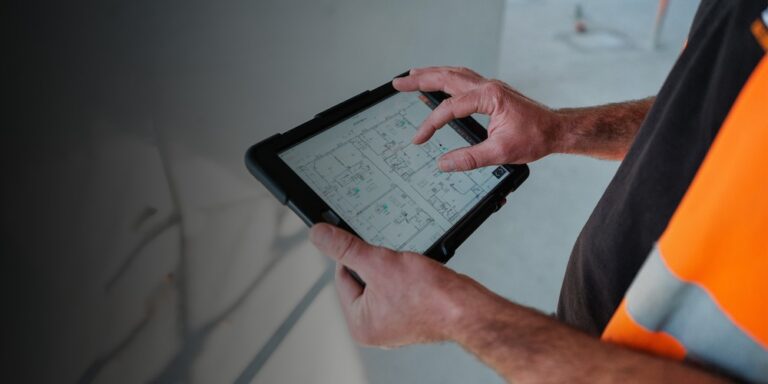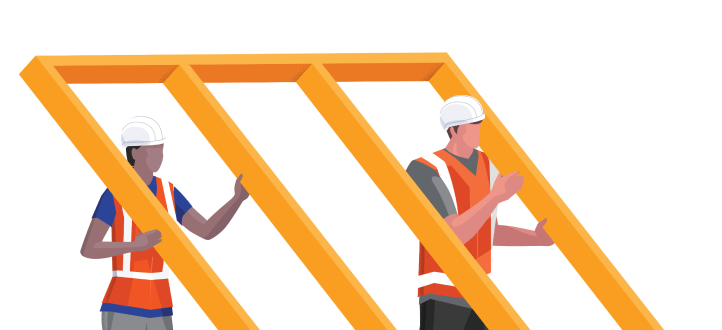— 10 min read
The Importance of As-Built Drawings in Construction Projects
Last Updated Dec 18, 2023

As-built drawings may not be at the top of your list of priorities, but it’s time to rethink that list. These drawings play a crucial role in construction projects as they document the actual construction of a building or infrastructure project, rather than the initial design.
During construction, unforeseen conditions or modifications may lead to changes in the original design. Therefore, as-built drawings are critical references for contractors, architects, engineers, and other stakeholders to make sure that the project is built according to the intended design. As-built drawings serve as an essential record of the project, which can be used for maintenance, repairs, renovations, or any other modifications in the future.
The construction industry is a significant contributor to the Australian economy, accounting for 9% of the country's GDP. As the industry continues to grow, the demand for accurate and comprehensive documentation -- including as-built drawings -- has become increasingly important.
Table of contents
What are as-built drawings?
As-built drawings refer to the final set of drawings that reflect the actual construction of a building or infrastructure project, rather than the initial design. Though they may not seem a top priority, these drawings document the exact location, dimensions, and specifications of every component of the project as it was actually built.
During construction, there may be changes made to the original design due to unforeseen conditions or modifications. As a result, the as-built drawings are a critical reference for contractors, architects, engineers, and other stakeholders to ensure that the project is constructed according to the intended design and that any changes made during construction are accurately reflected in the final product.
By comparing the as-built drawings to the original design and specifications, you can identify any deviations or discrepancies that may have occurred during construction.
As-built drawings also serve as an essential record of the project, which can be used in the future for maintenance, repairs, renovations, or any other modifications. Without accurate as-built drawings, it may be challenging to identify and resolve issues that arise during the lifespan of the building or infrastructure project.
These drawings are generally created by the contractor or construction team responsible for building the project. In some cases, the original design team may also be involved in creating as-built drawings.
The Purpose of As-Built Drawings
As-built drawings provide an accurate record of the final construction of a project. They provide a common reference point that everyone can use to understand the construction of the project and to make any necessary modifications or repairs.
Get the eBook: Creating Reliable As-Built Drawing Sets
1. Record Design Changes
Comparing as-built drawings to the original design is a vital step in the construction process. By doing so, you can determine whether the final product matches the original design and specifications, and verify that any changes made during construction are reflected accurately.
Additionally, comparing the as-built drawings to the original design can provide insights into any issues or challenges that arose during the construction process and help to inform future projects.
2. Provide Accurate Data for Repairs & Maintenance
As-built drawings are an essential tool for future maintenance, repairs, renovations, and equipment replacement. They provide information about the final state of a construction project, helping to streamline future work and ensure that everything functions as intended. By relying on high-quality documentation created by skilled professionals, construction projects can be completed with confidence and success.
3. Prevent Mistakes & Rework
These drawings can prevent mistakes and expensive rework by ensuring that the final construction of a building or infrastructure project is completed according to the intended design and specifications. As-built drawings provide a clear record of the final construction of the project, which can be compared to the original design to identify any deviations. By identifying these deviations early on, corrections can be made before they become more costly to fix.
4. Comply With Regulations & Standards
As-built drawings play a significant role in ensuring compliance with governmental regulations and standards in construction projects, like the National Construction Code. By carefully reviewing as-built drawings, you can ensure that all applicable local building codes, zoning regulations, safety standards, and other requirements are met. T
his documentation can help identify and rectify any deviations from regulations, ensuring that the final product is fully compliant and safe.
Types of As-Built Drawings
There are several different types of as-built drawings that may be produced during a construction project, depending on the specific requirements of the project and the needs of the stakeholders involved.
Architectural
Architectural as-built drawings are a set of drawings that document the final construction of a building or structure. Think of it like a map or blueprint of the finished building that shows all the details of how it was built.
These drawings are created after construction is complete and show the exact dimensions, locations, and specifications of all the building's components, such as walls, doors, windows, floors, and ceilings.
Architectural as-built drawings are important because they provide a permanent record of the building's final configuration and can be used for future reference, maintenance, or modifications.
Structural
Structural as-built drawings are a set of drawings that document the final construction of a building or structure from a structural perspective. These drawings show the details of how the building's frame and supporting structures were built, including its columns, beams, trusses, walls, and foundations.
Think of structural as-built drawings like the skeleton of a building: a building's structural ‘bones’ or components that provide support and stability for the building's walls, floors, and roof.
Structural as-built drawings are important because they provide a permanent record of how the building was constructed from a structural perspective.
Electrical
Electrical as-built drawings are a set of drawings that document the final electrical construction of a building or structure. These drawings show the layout, placement, and connections of all the electrical components within the building, such as electrical panels, switches, outlets, and light fixtures.
Think of electrical as-built drawings like a map or blueprint of the electrical wiring and components of a building. They show how the electricity flows through the building and how all the electrical components are connected.
Electrical as-built drawings are important because they provide a permanent record of how the building's electrical system was constructed.
Mechanical
Mechanical as-built drawings are a set of drawings that document the final mechanical construction of a building or structure. These drawings show the layout, placement, and connections of all the mechanical components within the building, such as heating, ventilation, and air conditioning (HVAC) systems, plumbing, and fire protection systems.
Think of mechanical as-built drawings like a blueprint for a building's internal systems. They show how the mechanical components are installed and connected within the building, and how they work together to provide a comfortable and safe environment for the building's occupants.
Mechanical as-built drawings are important because they provide a permanent record of how the building's mechanical systems were constructed. This record can be used for future reference, maintenance, or modifications.
Related: How BIM Improves Project Outcomes
How to Prepare As-Built Drawings
Preparing as-built drawings requires meticulous attention to detail and accuracy. The process involves reviewing original plans, taking field measurements, completing drawings, digitising photos, and updating original design plans. As-built drawings are created by the team responsible for building the project.
Field walkthroughs
Field walkthroughs provide an opportunity to verify that the information in the as-built drawings is accurate and up to date. They allow for a visual inspection of the building or structure, which can reveal details that may not be apparent from plans or other documentation.
Field walkthroughs involve visiting the construction site and examining the building or structure to identify any changes or modifications made since the original design. During a field walkthrough, you can take measurements, make sketches, and document any changes or modifications that have been made. This ensures that the as-built drawings accurately reflect the final construction of the building or structure.
Review of Completion Certificates
Completion certificates are important documents that serve as a seal of approval for a building or structure. They confirm that the construction process followed the detailed plans and specifications, ensuring that everything is built according to standards. These certificates provide reassurance to anyone entering the building that it is safe and secure.
When creating as-built drawings, it's crucial to take a look at the completion certificates.
These certificates are like a report card for the building or structure, indicating if all the necessary inspections and approvals have been obtained. By reviewing these certificates, we can make sure that the building complies with the rules and regulations set by building codes and standards.
In the completion certificates, you can also find information about important systems like mechanical, electrical, and structural components of the building. They also mention any inspections that took place during the construction process. This thorough review ensures that everything is up to par and in line with the required guidelines.
Change Order Evaluation
A change order evaluation is the process of assessing any modifications or changes that were made during the construction of a building or structure. A change order is a written document that details any changes made to the original construction plans, including modifications to the design, materials used, or construction methods.
The change order evaluation process involves reviewing these documents to determine how they impacted the construction of the building or structure. During the change order evaluation process, the as-built drawings are compared to the original construction plans to identify any differences or modifications.
Digital Photograph Collection
A digital photograph collection in as-built drawings refers to a set of digital photographs that are taken during the construction of a building or structure and used to document the progress of the construction.
These photographs are then incorporated into the as-built drawings to provide a visual record of the construction process.
Digital photograph collections in as-built drawings can include photographs of various aspects of the construction process, including excavation, foundation work, framing, installation of mechanical and electrical systems, and finishing work.
The photographs can be taken by the construction team or by a third-party photographer and can be captured using a variety of devices, including digital cameras, smartphones, or drones.
Digital photograph collections and other technology are becoming increasingly popular in as-built drawings to supplement other documentation, such as construction plans and specifications.
Using Technology for Better As-Built Drawings
Producing accurate and high-quality as-built drawings is an important aspect of construction project management. With the advancements in construction project management technology, it is now easier than ever to produce top-quality as-built drawings that are more accurate, efficient, and cost-effective.
Through the use of Business Information Modeling (BIM) software, mobile devices, and automated workflows, construction project teams can improve the accuracy and completeness of as-built drawings and ensure that they reflect the final construction of the building or structure.
Procore's digital toolbox for managing as-built drawings offers a comprehensive solution for construction project management. By utilising these tools, you can streamline your workflow, reduce errors, and ensure that everyone on your team has access to the information they need to keep your project on track.
Categories:
Tags:
Written by
Emma De Francesco
13 articles
Emma is currently Strategic Product Consultant at Procore where she loves partnering with clients to help them achieve the best possible results. She has worked as a Project Manager in previous roles, responsible for overseeing small to medium-sized projects across various sectors including commercial, health and lifestyle, retail, government and hotels. Throughout these projects, she managed everything from project costs, program and quality & safety, to design management, procurement, and authority approvals.
View profileExplore more helpful resources

Workforce Scheduling in Construction: 8 Tips To Improve Labour Productivity
Proper scheduling of construction labour and resources can result in increased productivity, lower costs, and improved timelines, allowing for successful project completion. By understanding a project’s requirements, assessing the resources...
Jobsite Communication Best Practices for Head Contractors
Effective communication serves as the foundation for driving success in construction projects. From planning to execution, clear and efficient communication plays a crucial role in ensuring seamless coordination, minimising errors,...

How Cost-Plus Contracts Work in Construction
A cost-plus contract provides reimbursement for all of the costs associated with a construction project, plus a fee to account for the contractor’s overhead and profit. Construction project owners may...

Construction Insolvency: Preventive Strategies for Contractors & Builders
Construction is one of the most vulnerable industries for insolvency, and that’s during a typical economic climate. When you pile on challenges with supply chains and labour availability — in...
